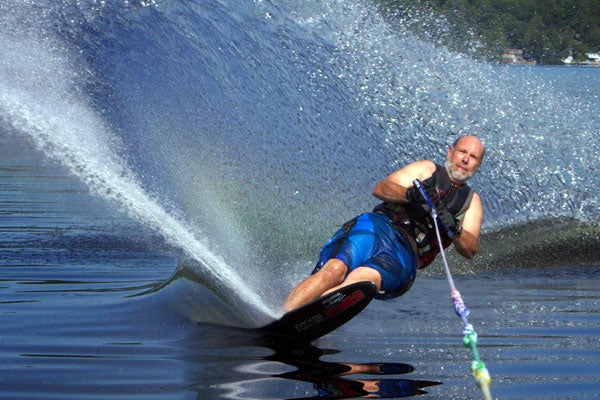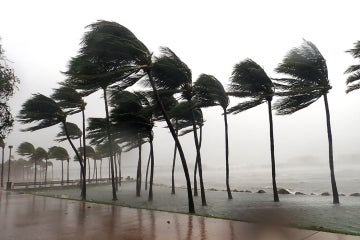
Pan Am Parapan Am volunteering: meet Terry Jones, water-ski enthusiast
Published: July 25, 2014
Few people realize that water-skiing and wakeboarding are competitive events at the Pan Am Games.
In fact, both sports made their Games debut in 1995 at the 12th Pan American Games in Mar del Plata, Argentina and, in the last five Games water-skiing accounted for 4.7 per cent of Canada's medals.
With the official countdown to Toronto 2015 Pan Am/Parapan Am Games (TO2015) underway, writer Kelly Rankin asked Terry Jones, a University of Toronto IT Analyst, Pan Am Games volunteer and water-skiing aficionado about the sport and his role at the Games.
How did you become interested in water-skiing?
I have been interested in water-skiing since I learned at a friend’s cottage when I lived in Winnipeg at about age 12 or 13. I skied whenever I could, but that was usually only a couple of weekends every summer.
That changed when I was a student at U of T. I sailed Laser sailboats with another U of T student, Geoff Chandler, and we were relaxing after a sail down at Bluffers Park in Scarborough when he asked if I liked water-skiing. I said I love it. He said, “let’s buy a boat.” That’s when I became a water-skier. It has been a passion, or maybe obsession, since then.
What is your role in the TO2015 Games?
My official role at the Games will be supervisor of venue technology, scoring and results for water-skiing. I will be responsible for planning site setup prior to the events and making sure things like computer-scoring information is transmitted to the Pan Am scoring systems. This is where my computer experience meets water-ski venue and operations.
I am also a certified Pan Am judge, and will judge events if called upon.
Preparations for the 2015 Pan Am Games have been underway for literally years and many of the Ontario officials, myself included, studied and wrote exams to earn our Pan Am Level Judge ratings so that we could judge the events. Whether I will judge or not depends on how many volunteers we have from all over the Pan Am Regions, but I am ready if needed.
How are computers used in the water-skiing events?
We use special computers with video cameras to measure how far ski jumpers fly before they land by capturing a short movie of them landing in an area that has survey markers in the water.
Ski jumping is measured like the long jump, but in our case the landing area is water, not sand, so we have to record the splash to measure where the skier lands.
We can move a video frame forward or backward to find where the skier first touches the water. We then mark that point on the screen and, since we have told the computer where the survey markers are on the screen, the computer can quickly extrapolate where the skier touched the water first.
How do you feel about the Pan Am Games being hosted by Toronto, with many events taking place at U of T?
I think Toronto is a great place to have the Pan Am games and I am sure the people of Toronto will make all the Pan Am visitors welcome. The preparation for the games, especially at U of T, will leave a legacy of amazing sports venues for years to come, such as the field hockey venue on the back campus and the aquatic facility at U of T, Scarborough. Hopefully this will lead to future Pan Am and Olympic champions coming from U of T.
What are some things judges look for when scoring competitive water-skiing?
Unlike some sports, water-skiing is not a subjective sport when it comes to judges. There are three events in water-skiing; slalom skiing, tricks competition and the jump event.
Slalom is measured by how many passes a skier can make through a course of six buoys, where each pass is made more difficult by increasing the speed - up to a maximum of 58km per hour. Once maximum speed is reached then the skier’s rope is shortened making it more difficult to get their ski around the buoys. A missed buoy ends a skier’s slalom attempt.
For tricks, the skier has two timed 20-second passes in which they can complete as many tricks as possible. Each pass starts when they attempt their first trick. Each trick is assigned specific points based on the degree of difficulty. There are no partial points, either a trick is done according to the criteria or it is not. Each pass ends when they fall or when the 20 seconds runs out.
In the jump event, skiers ski over a ramp that is between five and six feet high off the water. The computers and cameras measure how far they have jumped. The key to greater distances is going as fast as possible over the ramp by waiting as late as possible before cutting towards the ramp, timing your upward spring precisely while on the ramp, and maximum aerodynamic form while in the air.
However, regardless of how far the jump is, skiers have to ski away to get credit for a jump. Spectators can expect to see jumps up to 70 meters long! That’s two-thirds the length of a football field in the air! It’s spectacular to watch.
At the moment water-skiing is not an event in the Parapan Am Games. Do you know if there are any plans to change that?
It is unfortunate that water-skiing is not a Parapan Am sport at present. Canada has a strong adaptive water-ski program and regularly competes in the Adaptive World Championships. I hope water-skiing will become part of future Parapan Am Games.
What are you doing to support the games? Let us know your plans to volunteer in the coming months, your dreams of competing, coaching, or simply attending the games. Email the editor at U of T News: uoftnews@utoronto.ca.
Kelly Rankin is a writer with University Relations at the University of Toronto.



